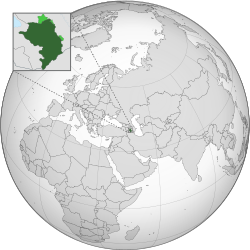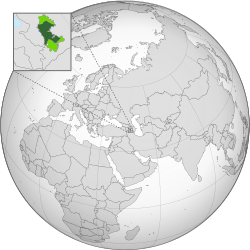Republic of Artsakh Republic of Nagorno-Karabakh Արցախի Հանրապետություն Artsakhi Hanrapetutyun Нагорно-Карабахская Республика Nagorno-Karabakhskaya Respublika | |||||||||||
|---|---|---|---|---|---|---|---|---|---|---|---|
| 1991–2023 | |||||||||||
Flag (1992–2023)
| |||||||||||
| Anthem: Ազատ ու Անկախ Արցախ Azat u Ankakh Artsakh "Free and Independent Artsakh" | |||||||||||
| Status | Unrecognised state; recognised by three non-UN-member states | ||||||||||
| Capital and largest city | Stepanakert 39°49′02″N 46°45′02″E / 39.81722°N 46.75056°E | ||||||||||
| Official languages | Armenian[a] Russian[b] | ||||||||||
| Ethnic groups (2015 census)[2] | |||||||||||
| Demonym(s) | Artsakhi | ||||||||||
| Government | Unitary semi-presidential republic (until 2017) Unitary presidential republic (from 2017) | ||||||||||
| President | |||||||||||
• 1994–1997 (first) | Robert Kocharyan | ||||||||||
• 2023 (last) | Samvel Shahramanyan | ||||||||||
| Prime Minister | |||||||||||
• 1992 (first) | Oleg Yesayan | ||||||||||
• 2023 (last) | Artur Harutyunyan | ||||||||||
| Legislature | National Assembly | ||||||||||
| Independence from the Soviet Union | |||||||||||
| 20 February 1988–12 May 1994 | |||||||||||
• Proclamation of the republic | 2 September 1991[3] | ||||||||||
| 10 December 1991 | |||||||||||
| 27 September–10 November 2020 | |||||||||||
| 12 December 2022 | |||||||||||
| 19–20 September 2023 | |||||||||||
| 28 September 2023 | |||||||||||
| Area | |||||||||||
• Total | 3,170[4] km2 (1,220 sq mi) | ||||||||||
| Population | |||||||||||
• March 2021[5] estimate | 120,000 | ||||||||||
• 2015[2] census | 145,053 | ||||||||||
| GDP (PPP) | 2019 estimate | ||||||||||
• Total | $713 million | ||||||||||
• Per capita | $4,803 | ||||||||||
| Currency | (AMD) | ||||||||||
| Time zone | UTC+4 (AMT) | ||||||||||
| Drives on | right | ||||||||||
| Calling code | +374 47[c] | ||||||||||
| |||||||||||
| Today part of | Azerbaijan | ||||||||||
Artsakh (/ˈɑːrtsɑːx, -sæx/ ART-sa(h)kh), officially the Republic of Artsakh[d] or the Republic of Nagorno-Karabakh (/nəˌɡɔːrnoʊ kərəˈbɑːk/ nə-GOR-noh kər-ə-BAHK),[e][7] was a breakaway state in the South Caucasus whose territory was internationally recognised as part of Azerbaijan. Between 1991 and 2023, Artsakh controlled parts of the former Nagorno-Karabakh Autonomous Oblast of the Azerbaijani Soviet Socialist Republic, including its capital Stepanakert. It had been an enclave within Azerbaijan from the 2020 Nagorno-Karabakh war until the 2023 Azerbaijani offensive, when the Azerbaijani military took control over the remaining territory controlled by Artsakh. Its only overland access route to Armenia after the 2020 war was via the five kilometres (3.1 mi)–wide Lachin corridor, which was placed under the supervision of Russian peacekeeping forces.[8]
The predominantly Armenian-populated region of Nagorno-Karabakh was claimed by both the Azerbaijan Democratic Republic and the First Republic of Armenia when both countries became independent in 1918 after the fall of the Russian Empire. A brief war over the region broke out in 1920. The dispute was largely shelved after the Soviet Union established control over the area, and created the Nagorno-Karabakh Autonomous Oblast (NKAO) within the Azerbaijan SSR in 1923. Throughout the Soviet period, Armenians in the Nagorno-Karabakh Autonomous Oblast were heavily discriminated against. The Soviet Azerbaijani authorities worked to suppress Armenian culture and identity in Nagorno-Karabakh, pressured Armenians to leave the region and encouraged Azerbaijanis to settle within it, although Armenians remained the majority population.[9]
In the lead-up to the dissolution of the Soviet Union in the late 1980s, the region re-emerged as a source of dispute between Armenia and Azerbaijan. In 1991, a referendum held in the NKAO and the neighbouring Shahumyan Province resulted in a declaration of independence. The conflict erupted into a full-out war in 1992.[8] The war was won by Artsakh with support from Armenia. Although a ceasefire agreement was signed in 1994, the frozen situation left the predominantly Armenian-populated territory de facto independent, with a self-proclaimed government in Stepanakert, but still heavily reliant on and closely integrated with Armenia, in many ways functioning as a de facto part of Armenia.[10][11] Even though Armenia never officially recognized the region's independence, it became the main financial and military supporter of the territory.[12][13] In 2017, a referendum in the area approved a new constitution that transformed the system of government from a semi-presidential to a presidential democracy with a unicameral legislature in addition to changing the name of the state from the Republic of Nagorno-Karabakh to the Republic of Artsakh, although both names remained official.
From 1994 until 2020, Armenian and Azerbaijani troops remained separated by a contested line of contact[14] which saw sporadic deadly incidents during the intervening years.[15] In 2020, a new war was fought in the region,[8] with Azerbaijan achieving victory and regaining all the surrounding occupied districts and a significant portion of Artsakh's claimed territory.[10][13][15] The Lachin corridor linking Artsakh to Armenia was blockaded by Azerbaijan in December 2022. In September 2023, Azerbaijan launched another military offensive. The government of Artsakh agreed to disarm and enter talks with Azerbaijan, prompting a flight of ethnic Armenians from the area. On 28 September 2023, the president of Artsakh subsequently signed a decree to dissolve all of the republic's institutions by 1 January 2024,[16] though the president later attempted to annul this decree.[17] By 1 October 2023, almost the entire population of the region had fled to Armenia.[18]
Cite error: There are <ref group=lower-alpha> tags or {{efn}} templates on this page, but the references will not show without a {{reflist|group=lower-alpha}} template or {{notelist}} template (see the help page).
- ^ Парламент Карабаха признал русский язык официальным языком республики [Parliament of Karabakh recognized Russian as the official language of the republic] (in Russian). Арменпресс [Armenpress]. 25 March 2021. Archived from the original on 26 May 2021. Retrieved 4 August 2021 – via RBK Group.
- ^ a b Таблица 5.2-1 Население (городское, сельское) по национальности, полу (PDF) (in Russian). Archived from the original (PDF) on 31 July 2018. Retrieved 31 July 2018.
- ^ Zürcher, Christoph [in German] (2007). The Post-Soviet Wars: Rebellion, Ethnic Conflict, and Nationhood in the Caucasus ([Online-Ausg.]. ed.). New York: New York University Press. p. 168. ISBN 9780814797099.
- ^ "Территориальные потери Арцаха в результате второй Карабахской войны (статистика и карты)". Archived from the original on 28 November 2020. Retrieved 9 March 2023.
- ^ "Nikol Pashinyan, Arayik Harutyunyan chair meeting on ongoing and upcoming programs to be implemented in Artsakh". primeminister.am. The Office to the Prime Minister of the Republic of Armenia. 25 March 2021. Archived from the original on 13 May 2021.
...today most of the population – about 120,000 citizens – live in Artsakh...
- ^ "Search". 29 September 2023. Archived from the original on 26 September 2023. Retrieved 26 September 2023.
- ^ "Constitution of the Republic of Artsakh". Ministry of Foreign Affairs of the Nagorno Karabakh Republic. Archived from the original on 27 October 2022. Retrieved 19 April 2020.
The names 'Republic of Artsakh' and 'Republic of Nagorno-Karabakh' are identical.
- ^ a b c Wilson, Audrey (4 August 2022). "Violence Flares in Nagorno-Karabakh". Foreign Policy. Washington, D.C.: Graham Holdings Company. ISSN 0015-7228. Archived from the original on 9 August 2022. Retrieved 14 August 2022.
- ^ Parts of a Circle I: The Road to War (Documentary). Media Initiatives Center, Internews Azerbaijan, and the Humanitarian Research Public Union. May 2020.
- ^ a b "Nagorno-Karabakh Conflict". Council on Foreign Relations. Archived from the original on 29 September 2023. Retrieved 29 September 2023.
- ^ Cite error: The named reference
hugheswas invoked but never defined (see the help page). - ^ "Nagorno-Karabakh profile". BBC News. 7 September 2023. Archived from the original on 30 November 2020. Retrieved 29 September 2023.
- ^ a b Andrew Higgins; Ivan Nechepurenko (27 September 2023). "A Stunningly Sudden End to a Long, Bloody Conflict in the Caucasus". The New York Times. Archived from the original on 29 September 2023. Retrieved 29 September 2023.
- ^ "How the Nagorno-Karabakh conflict has been shaped by past empires". National Geographic. 25 September 2023. Archived from the original on 29 September 2023. Retrieved 29 September 2023.
- ^ a b "The Nagorno-Karabakh Conflict: A Visual Explainer". International Crisis Group. Archived from the original on 29 June 2020. Retrieved 29 September 2023.
- ^ "Nagorno-Karabakh Republic will cease to exist from Jan 1 2024 – Nagorno-Karabakh authorities". Reuters. 28 September 2023. Archived from the original on 28 September 2023. Retrieved 28 September 2023.
- ^
- Stepanian, Ruzanna (29 March 2024). "Karabakh Figures Reject Pashinian's Threats". «Ազատ Եվրոպա/Ազատություն» ռադիոկայան (in Armenian). Retrieved 22 September 2024.
- "France 24 via msn.com". www.msn.com. Retrieved 2 January 2024.
- "Artsakh Leader Annuls Earlier Decree to Dissolve Government". Hetq.am. 22 December 2023. Retrieved 2 January 2024.
- "Artsakh Dissolution Decree Annulled – Asbarez.com". 22 December 2023. Retrieved 2 January 2024.
- Presse, AFP-Agence France. "Karabakh Dissolution Not Valid, Says Separatist Leader". www.barrons.com. Retrieved 2 January 2024.
- ^ "Nagorno-Karabakh almost empty as most of population flees to Armenia". Radio France Internationale. 30 September 2023. Archived from the original on 2 October 2023. Retrieved 30 September 2023.



